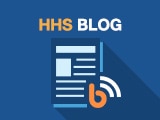#IAmHHS: Seeing People for Their Strengths, Not Their Weaknesses
For nearly 40 years, my career has revolved around ensuring the humane care and management of laboratory animals used in biomedical research. I am really not a person who likes to sing my own praises, but for background, I am the chief of Animal Program Administration at the National Eye Institute (NEI), which is part of the National Institutes of Health. I have been president of professional societies and served on boards. And I have co-edited a leading text book on the management of laboratory animal care and use programs.
But even with all this, I consider one of my most important career accomplishments to be motivated by a simple question that was posed to me at a Special Olympics holiday party back in 2005: “Hey Doc, how about getting me a job?”
Joe Wu, a person with intellectual developmental disabilities, asked me that question over a decade ago. He eventually became my colleague at NEI.
I had gotten to know Joe because like my daughter, Gretchen, who had special needs, he is involved with the Special Olympics. He started working with us at NEI as a volunteer and through hard work in our program, he earned a full time job.
Over time, we have expanded the program to hire additional people with intellectual and development disabilities, and today, we have five people working with us.

Let there be no doubt: The program is a win-win, and not charity of any kind. It takes a team effort, and the work can be strenuous at times. Providing husbandry and caring for lab animals is not a glamorous or high-paying job, and there has been a fairly high turnover in some of the entry and mid-level positions. But our staff with intellectual and developmental disabilities are some of the most dedicated, proudest, hardest workers we have, and they are happy in their positions. During snowstorms, some have slept on cots in the facility to make sure they don’t miss work.
One of the most satisfying things for me is having families tell me how overjoyed they are because their adult children have finally found a workplace where their contributions are deeply appreciated, where they have purpose and where they have the opportunity to achieve greater levels of responsibility. The result has been very positive and even inspiring for our entire work group.
The one big “take away” here is to see people for their strengths, not just their weaknesses. Everybody’s contribution to the team is valued and important.
It’s really gratifying to me to be in a federal agency that allows this kind of program to happen, to take root and flourish. Yes, there were logistical processes to work through, and special training required for both the individuals with special needs and the other people who work with them. But in the end, it goes back to what a career in government means: service to the community.
I’m Dr. Robert Weichbrod. I work for the National Eye Institute. And I Am HHS.
Rob is one of more than 79,000 people who make HHS run every day. You can share his story and see others on Twitter and Facebook using #IAmHHS.
Find out how Rob Weichbrod has made a difference in the lives of many people & families with disabilities. #IAmHHS https://go.usa.gov/xRwbd
Standing by Texas and Louisiana in the Face of Hurricane Harvey
Here’s What’s So Great about Community Health Centers
